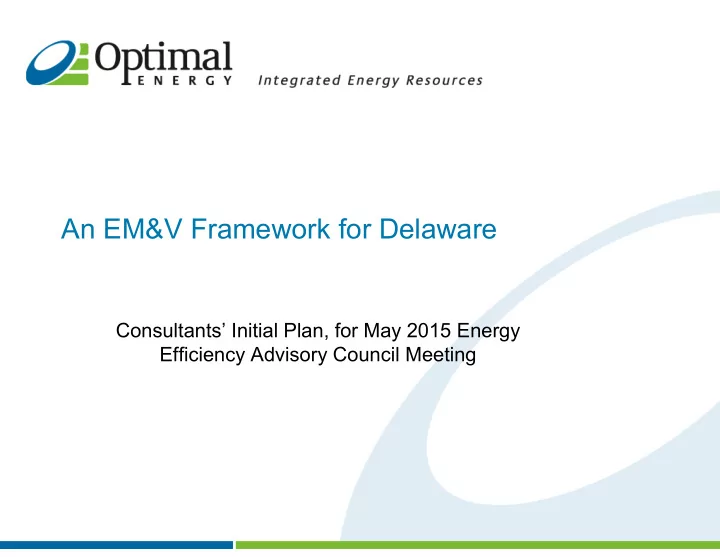

An EM&V Framework for Delaware Consultants’ Initial Plan, for May 2015 Energy Efficiency Advisory Council Meeting
Presentation Outline – Structure vs. Content Structure covers how evaluation activities occur – Roles and Responsibilities – Collaborative philosophy Content covers some of the key issues in evaluation – Application of savings – Cost-effectiveness – TRM Updates 2
A Collaborative EM&V Framework More emphasis on flexibility and cost-efficiency Utilize existing best practices, standards, and protocols Result: better outcomes, in less time, for less $$ – Everyone agrees beforehand on methodology, avoids most post-evaluation arguments or need to redo studies Statewide efforts whenever possible – More cost-effective – Adds explanatory power 3
EM&V Roster EM&V Collaborative – A group composed of AEP/PA representatives and EEAC’s consultants DNREC – State authority on EM&V EEAC Consultants – Team includes experts in program areas and evaluation AEPs/PAs – Any AEP, plus SEU; each will designate a representative for the Collaborative Independent Evaluation Contractor(s) – selected jointly by Collaborative by competitive bid 4
Positions Played EM&V Collaborative – Issues RFP for IEC(s); establishes multi-year evaluation plan and budget; discusses and approves individual study plans, work products, and reports DNREC – Promulgates regulations; hires and manages EEAC Consultant EEAC Consultants – Reviews and approves selection of IECs; oversees planning of EM&V activities AEPs/PAs – Contracts with IECs; tracks and provides data; identifies EM&V needs Independent Evaluation Contractor(s) – completes all primary EM&V activities 5
Programs Evaluated Using Ex-Post Verified Net Savings Gross savings determined by best available method (e.g., billing analysis, engineering analysis, TRM deemed savings) Savings as verified, may be adjusted based on primary EM&V but no retrospective changes to deemed savings Net savings calculated using pre-determined NTG ratios, prospectively Changes to TRM are prospective, covered in annual update 6
Portfolio Level Cost-effectiveness Using TRC Total Resource Cost (TRC) test applied as per Framework Captures full effective useful life of measures, discounting at societal rate Benefits – All avoided energy and capacity benefits – DRIPE – Non-energy benefits (quantifiable and/or adder) Costs – Program administration costs – Incremental measure costs (up to and including labor as appropriate) – Non-energy costs (quantifiable and/or adder) 7
Regular TRM Updates Aligned with the update process for the Mid-Atlantic TRM Updates completed July 1 – Programs launched January 1 will use updated data in planning for the subsequent year – Programs launched in advance of January 1 of the subsequent year will use existing data until the start of the next program year DNREC maintains the proposed list of measure additions, deletions, or modifications for inclusion in the update 8
Making Utilities Whole: Three Components Recover 100% of program costs Lost Net Revenue Remove dis-incentives: Cost Recovery address lost net revenues Provide positive incentives: Performance Incentive measurable metrics Utility “made whole” 9
Thank You Phil Mosenthal & Bob Wirtshafter Optimal Energy, Inc. 10600 Route 116, Suite 3 Hinesburg, VT 05461 802-482-5600
Guidance on Cost Recovery and Performance Incentives Caveat: for those AEPs that are regulated by the PSC, cost recovery and performance incentives are the purview of the Commission Three key components Recover program costs Lost Net Revenue Cost Address lost net revenues Recovery Provide incentives (evaluators need to recommend measurable metrics) Performance Incentive Utility “made whole” 11
Collect 100% of Actual Program Costs Strive for proportional allocation of costs by customer class, except for low income Amortizing program costs to better align with program benefits has merit, but interest rate likely < WACC Annual true-up of under/over-collection Program costs NOT included in rate-base 12
Remove Dis-incentives for Efficiency Decoupling is a possibility Lost revenue adjustments should NOT be made in isolation; AEPs should not earn above actual net lost revenue – Example: Verified efficiency savings of 1,00 MWh, but AEP only 350 MWh short (e.g., hot summer, economic expansion) Annual true-up 13
Provide Positive Incentives Give EE/DR similar earnings potential as supply-side investments Protect ratepayers against excessive awards Based on measureable performance under the AEP’s control Tied to outcomes (e.g., verified savings, market transformation, cost of savings) rather than actions (e.g., expenditures, meetings, events) Scalable, multi-variate, and multi-year 14
Recommend
More recommend